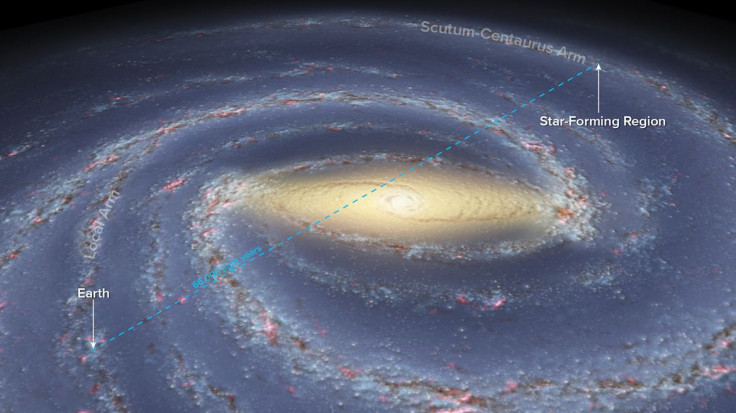Milky Way Measured From End To End, Could Help Map Galaxy

Using a 180-year-old technique and a continent-wide radio telescope system, scientists have directly measured the distance of a region all the way across from us at the other end of the Milky Way. The distance of 66,000 light-years almost doubles the previous record of the longest distance directly measured.
The direct measurement method used was trigonometric parallax, first used in 1838. In this method, a celestial object is observed from two distant points — such as opposite points in Earth’s orbit around the sun — and the relative change in its position in the sky is noted. Using the principles of trigonometry, and knowing the diameter of Earth’s orbit, the distance to the celestial object can be calculated, but with only as much precision as the measurement of the shift in the celestial object’s position.

The Very Long Baseline Array (VLBA), which is a network of 10 radio telescopes spread across North America, Hawaii and the Caribbean, is capable of measuring those small angular shifts very precisely. In the case of the star-forming region called G007.47+00.05 at the other end of our galaxy, that would be “roughly equal to the angular size of a baseball on the Moon,” according to a statement Thursday by the National Radio Astronomy Observatory (NRAO).
VLBA made these measurements in 2014 and 2015, NRAO said. The last record for a parallax-based direct measurement was 36,000 light-years. The galactic center is about 27,000 light-years from where we are. That means G007.47+00.05 is farther than twice the distance to the center of the Milky Way.
“This means that, using the VLBA, we now can accurately map the whole extent of our galaxy. Most of the stars and gas in our galaxy are within this newly-measured distance from the sun. With the VLBA, we now have the capability to measure enough distances to accurately trace the galaxy’s spiral arms and learn their true shapes,” Alberto Sanna of the Max-Planck Institute for Radio Astronomy in Germany (MPIfR), said in the statement.
Milky Way is a flattened spiral galaxy with many arms and our solar system is at the outer edge of the galaxy in one of the arms. Since we are inside the galaxy, it is difficult for us to see its actual shape and structure, because that would require travelling hundreds of thousands of light-years, at the very least, to a distance from where the whole of the galaxy is visible face-on.
Using VLBA to target star-forming regions within the galaxy allows us to circumvent that problem. Also, star-forming regions are rich in water and methanol, both of which amplify the radio signals that VLBA detects, acting as natural masers.
“The Milky Way has hundreds of such star-forming regions that include masers, so we have plenty of ‘mileposts’ to use for our mapping project, but this one is special. We’re looking all the way through the Milky Way, past its center, way out into the other side,” MPIfR’s Karl Menten said in the statement.
The research will be reported Friday in a study titled “Mapping spiral structure on the far side of the Milky Way” in the journal Science.
© Copyright IBTimes 2025. All rights reserved.





















